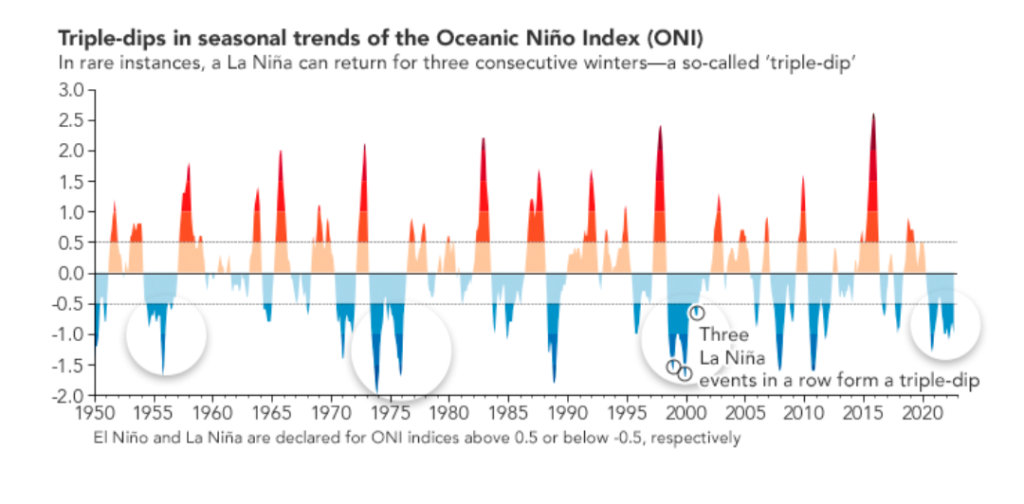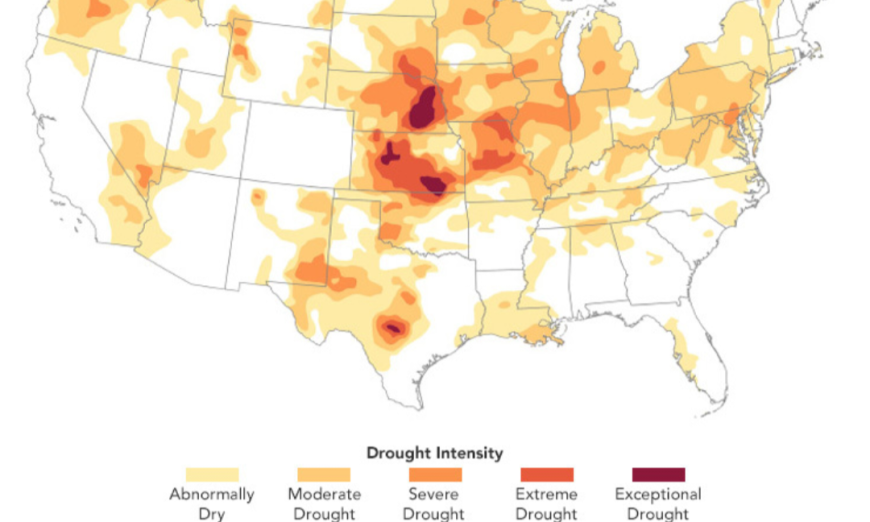June 20, 2023.
Kansas normally produces about 25 percent of the U.S. winter wheat crop, but that may not happen this year. As drought gripped the state for much of the growing season, wheat fields throughout Kansas have been filled with stunted and browning plants.
Going into the harvest season, which runs from June to mid-July, data from the U.S. Drought Monitor indicated that about two-thirds of the state’s wheat crop faced extreme or exceptional drought conditions for much of 2023. This follows a challenging 2022 season that was also plagued by drought and low yields.
The map above shows conditions in the continental U.S. as of June 20, 2023, as reported by the U.S. Drought Monitor, a partnership of the U.S. Department of Agriculture, the National Oceanic and Atmospheric Administration, and the University of Nebraska–Lincoln. The map depicts drought intensity in progressive shades of orange to red. It is based on an analysis of climate, soil, and water conditions measurements from more than 350 federal, state, and local observers around the country. NASA contributes several measurements and models that aid the drought monitoring effort.
According to the map, 79 percent of the land area in Kansas was in some level of drought. Six percent of the winter wheat crop—mostly in the center of the state—was in exceptional drought; 46 percent was in extreme drought, and 22 percent was in severe drought, according to data from the U.S. Drought Monitor. Data released by the U.S. Department of Agriculture indicates that more than half of the state’s wheat crop was rated as either “poor” or “very poor” in mid-June. Just 1 percent of the state’s wheat crop was rated as being in “excellent” condition. While parts of Nebraska and Texas also faced exceptional drought, it’s less common for farmers to grow winter wheat in these areas.
Agrometeorological (AGMET) Earth observations indicator data from the NASA Harvest Consortium underscore how challenging the season has been for wheat farmers in Kansas. One such indicator is the normalized difference vegetation index (NDVI)—a widely used measure of plant health based on the density of green leaves on vegetation. “The 2023 season has been close to the worst in the last decade, as evidenced by the historic low NDVI values and driven partly by below-average rainfall,” said University of Maryland and NASA Harvest Consortium researcher Ritvik Sahajpal. “There have been some showers in the critical May-June flowering time period that have helped elevate the NDVI values, but the conditions are poor overall.”
Prior to harvest, the USDA Economic Research Service projected the state’s farmers would produce 191 million bushels of wheat 2023, the smallest crop since 1961. That is substantially less than the 364 million bushels harvested in 2021 and 260 million bushels harvested in 2022. The 10-year average is 332 million bushels. Final numbers on the size of the 2023 harvest will be available later in the year.
Researchers who study how climate affects crops and food security see connections between what is happening in Kansas and global scale climate cycles and changes. “Attributing the specific causes of a drought is always complex and this drought undoubtedly had multiple causes,” said Weston Anderson, a University of Maryland climate scientist based at NASA’s Goddard Space Flight Center. “But I can say with certainty that droughts throughout the Southern Great Plains that lead to poor wheat yields are expected during La Niña years.”

Though El Niño conditions recently emerged in spring 2023, a prolonged La Niña held sway for three consecutive years prior to that (see the chart above). La Niña is an oceanic phenomenon characterized by the presence of cooler than normal sea-surface temperatures in the central and eastern tropical Pacific. It affects weather patterns throughout the globe, often bringing unusually dry weather to the U.S. Southwest.
Erin Coughlan de Perez, a Tufts University expert in climate risk management, recently published a study detailing the current risk of extreme events faced by wheat farmers in the U.S. The researchers analyzed four decades of seasonal forecasts and concluded that in 1981, extreme temperature conditions capable of damaging wheat were expected to occur approximately once in 100 years. Now, such conditions have a return period of one in six years.
They also found that these extreme temperature events are strongly correlated with drought. The study was part of a NASA-funded research project on extreme events in the United States, conducted in collaboration with the American Red Cross. “The risk of climate shocks has already increased for wheat farmers in the central U.S.,” Coughlan de Perez said. “Farmers need to be prepared for the unprecedented extremes that are coming.”
One new effort to address challenges like this is the NASA Acres Consortium, a U.S.-focused agriculture and food security program established by NASA in March 2023. The consortium focuses on applying satellite Earth observation information to the most pressing agricultural and food security challenges facing U.S. farmers, ranchers, and others with a stake in the food system.
“One of the main goals of NASA Acres is to use satellite data to improve the methods and tools available to rapidly assess extreme events,” said Alyssa Whitcraft, the director of the consortium. “We want to develop decision support tools to help build an agricultural system that is both resilient in the face of challenges now and prepared for uncertainty in the years to come.”
NASA Earth Observatory image by Wanmei Liang, using data from the United States Drought Monitor at the University of Nebraska-Lincoln. The La Niña chart was made by Joshua Stevens, using data from the Climate Prediction Center at NOAA. Story by Adam Voiland.
Source, NASA.

